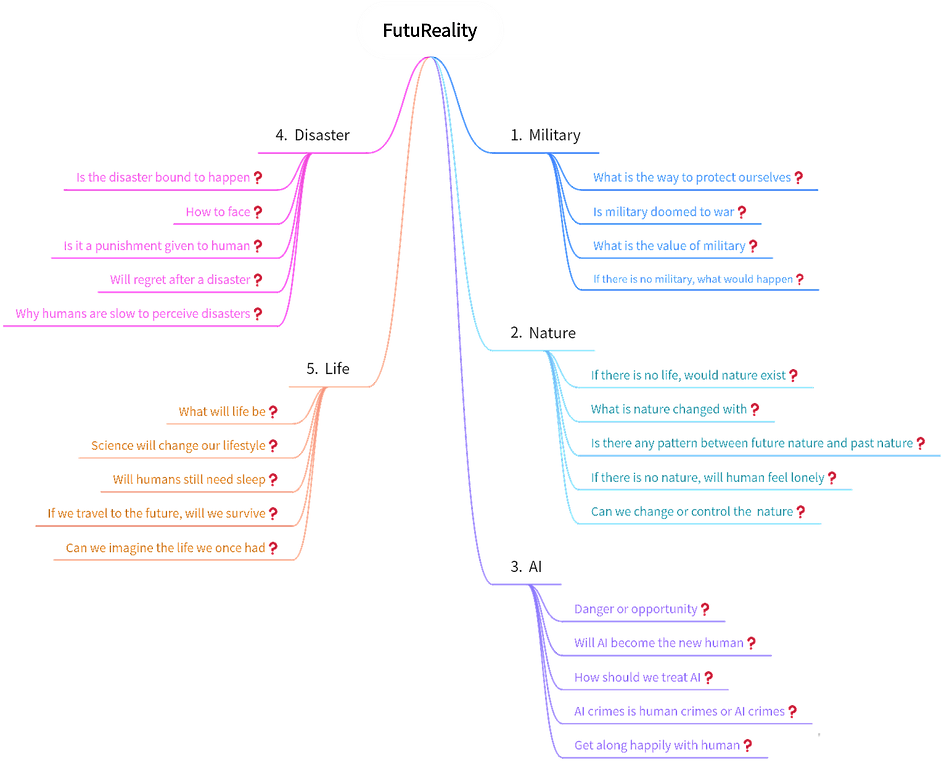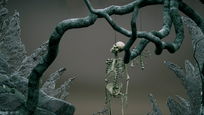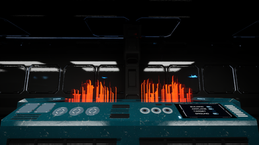
FutuReality: A Journey into Tomorrow's Worlds
Date
06/2023 - 09/2023
Category
VR, Metaverse, Game Design, Unreal, Narrative Storytelling
Designer
Introduction
"FutuReality: A Journey into Tomorrow's Worlds" is an VR digital exhibition that aims to lead users through an immersive exploration of future societal possibilities and challenges using virtual reality technology.
The significance of this project lies in its ability to blend education and entertainment seamlessly. We aspire to spark curiosity and contemplation about the future by providing a visually stunning and intellectually stimulating experience.
Tu Zhengyao
Exhibition
Scenario1: Military
Scenario2: Nature
Scenario3: AI
Scenario4: Disaster
Scenario5: Life
Research
With the renewed heated discussion of science fiction and the popularity of ChatGPT, "the future" seems to have become a question that we have to think about. So I also thought about the issue of “the future”.
I read Liu Cixin's fantasy novel "The Three-Body Problem". In his novels, he believes that people are romantic. Love and survival often blend together. This is a good guess for the future. And he believed that death was destined and instantaneous. Therefore, humans may suddenly disappear in the future. After reading his novels, I have more speculations about the future.


I also watched the "Love, Death & Robots" animation, as well as some other fantasy movies and TV series. I began to think about the relationship between robots and humans. It is difficult to determine whether such a relationship will be balanced in the future. Although we currently try to make robots work for us, will this still be the case in the future?


Brainstorming
So I hope to build a digital museum of the future. In order to determine the content of the exhibition hall, I brainstormed about "future".

Concept
The thematic core of our exhibition revolves around the multifaceted aspects of future societies, addressing technological advancements, environmental sustainability, human evolution, and potential crises. It's a kaleidoscope of possibilities and challenges.
Our design philosophy involves marrying elements of speculative fiction with real-world trends. This fusion creates a captivating narrative that guides users through a dynamic exploration of futuristic scenarios, both plausible and imaginative.

Moodboard
At the same time, I collage my emotional version of these themes. Mood boards help me have a more unified style when designing venues.

Scene Design
In order to give players a better gaming experience and ensure the smoothness of the venue. I decided to use portals as connections between venues.

Technical
After brainstorming, I identified a theme for each venue, for which I developed my technical directions and implemented them using visual programming.
VR device configuration
In order to allow players to control the game process through VR, I configured the input port of UE for VR. And some blueprints have been added to realize the most basic interactive actions of VR controllers, such as grabbing, lifting objects, etc.

VR equipment enters the scene
Write UE5 debugging VR device blueprint
Niagara effect implementation
Since a large number of holographic elements are used in future scenes, the dynamics of Niagara particle effects have become a top priority. To complete the particle effects, I built multiple Niagara systems and wrote blueprints.

Niagara particle animation variables
Niagara particle system connection
Niagara particle system construction
Niagara particle dynamic effects
Portal transition implementation
The portal that connects venues is also a part that cannot be ignored. At first, I just set up a simple venue switching setting without adding delays, fades and other effects. Later, after experiencing it, I felt that the scene switching was too abrupt, so I added some delay and fade-in effects. And combined with Niagara particle effects, the portal has a more sci-fi feel.


























